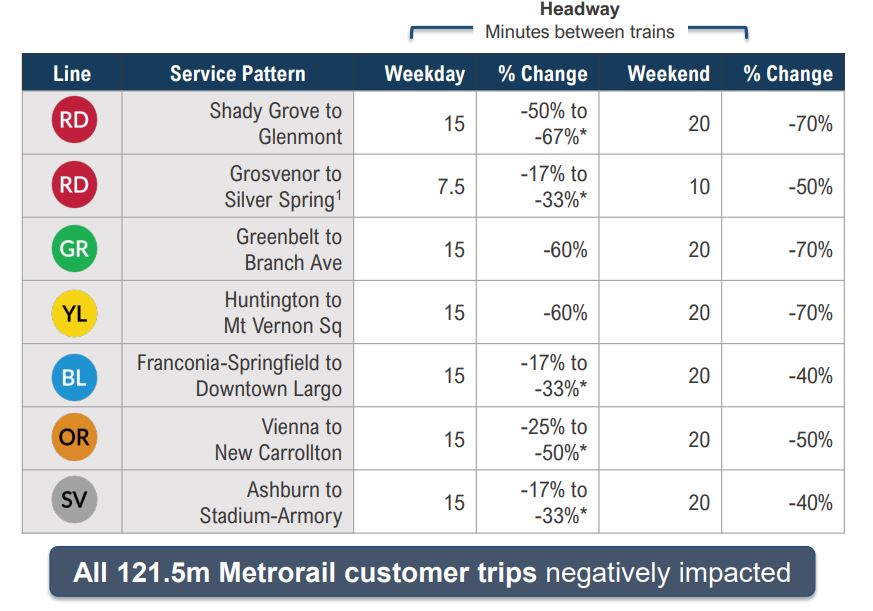Facing massive budget shortfall, Metro releases budget proposal that slashes service and increases fares
Metro this week released a proposed budget for its next fiscal year that, without additional contributions from Metro’s funding partners, would necessitate fare increases and drastic cuts to service and to Metro’s workforce, a worst-case scenario for the region’s economy, quality of life, and environment.Metro is unique among transit agencies in the United States in that it was structured without any independent funding and is legally required to pass a balanced budget every year. Despite an exhaustive effort to find internal savings, including $95 million in one-time savings carried over from FY24, $50 million in recurring annual savings and efficiencies, and a hiring and salary freeze, closing a gap of this size to pass a legally-required balanced budget requires drastically reducing rail, bus, and paratransit service, increasing fares, slashing Metro’s workforce, and deferring maintenance and modernization projects, ultimately making the system less safe and reliable.
“Metro is facing an unprecedented, existential crisis that requires our region to rally together if we want to avoid the catastrophic impacts this budget would have on our region,” said Metro General Manager and CEO Randy Clarke. “I’m so proud of Metro and our dedicated workforce that has helped deliver over a dozen recent service improvements and are providing great service for our region all day, seven days a week. We are doing everything in our power to avoid the doomsday scenario outlined in this budget proposal, but we must also be transparent and honest about how devastating these cuts would be if additional funding isn’t secured.”
Beginning in January, Metro will implement a hiring freeze, eliminate wage and salary increases, and issue legally required layoff notices to portions of its workforce alerting them to the potential of layoffs next summer if additional funding is not provided. Due to workforce attrition, customers could see degraded service as early as late winter or early spring.
Other proposals include:
Service
Metrorail
- System closure at 10 p.m., seven days a week
- Close 10 low-ridership stations
- Red Line turn-backs at Grosvenor-Strathmore and Silver Spring stations, reducing train frequencies for end-of-line stations
- Silver Line turn-back at Stadium-Armory with Silver Line service between Ashburn and Stadium-Armory only, reducing train frequencies to Downtown Largo
- Decreased service on all Metrorail lines: Reduce the number of trips with 6 minutes or better service from 81 percent in FY24 to 10 percent in FY25
Metrobus
- Eliminate service on 67 of 135 Metrobus routes
- Reduce Metrobus service on 41 of the remaining Metrobus routes
MetroAccess
- Service area reduced to align with reduced Metrobus and Metrorail service area, in accordance with federal law
- 320,000 annual trips negatively impacted
Fares
- Increase all fares by 20 percent, including Metrorail, Metrobus, MetroAccess, and discounted fare products
- Customers pay more for much-degraded service
Capital Budget
Metro’s robust capital improvement program in recent years has improved customer experience and satisfaction across the board, with less frequent infrastructure-related service disruptions, much-improved escalator availability, and modernized stations and customer amenities.
However, Metro is reluctantly proposing to use $193 million more in capital funding to cover operating maintenance expenses to help close the large gap in FY25. This shift is necessary for Metro to be able to provide even the much-reduced service levels proposed in FY25. Such a large transfer of capital funds to operating expenses puts the system’s state of good repair, including safety and reliability, at risk, and threatens to delay, defer, decrease, or cancel several long-term projects to modernize the system, including:
- Regular corrective maintenance
- New railcar maintenance and overhaul facility
- 8000-series railcar purchase options and ability to retire oldest, least reliable railcars
- Better Bus initiative, including goal to transition to 100 percent zero emission buses by 2042
Degraded customer experience
The combined effect of service cuts, fare increases, layoffs, and reduced capital spending on infrastructure would lead to a much-degraded customer experience. Impacts would include:
- Decreased safety and security due to reduced Metro Transit Police presence, longer police response times, weakened cybersecurity, and other risks
- Dirtier trains, buses, and stations, and reduced ability to deliver real-time trip information
- Reduced reliability across the board, from trains and buses to escalators and elevators
Public Input
Between now and February, Metro staff and the Board of Directors will finalize a budget proposal for the public’s input and comments. Check wmata.com/budget for FAQs and updates on the launch of a public comment period.
